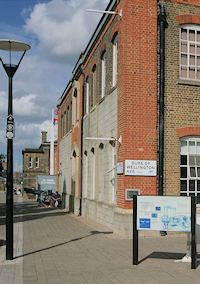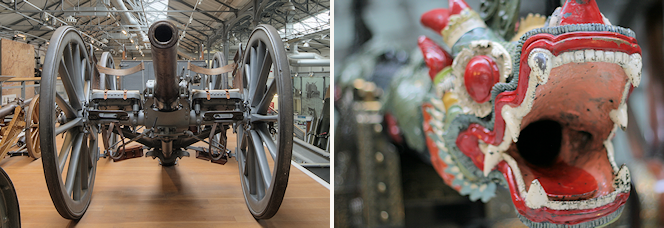Firepower
Now closed – page left up for posterity
Firepower – The Royal Artillery Museum, Royal Arsenal, Woolwich

The ordnance store and gun wharf at Henry VIII’s Royal Dockyard brought the first gunners to Woolwich in the 16th century.
In May 1716 the first two permanent companies of Royal Artillery were established by Royal Warrant. Each company numbered 100 men and their headquarters was Tower Place, in what later became the Royal Arsenal. A military academy was established at Woolwich in 1720 to provide training for Royal Artillery officers.
The unit was renamed the Royal Regiment of Artillery in 1722, though it’s still commonly known as the Royal Artillery or the RA. By 1757 the RA had grown to 24 companies, divided into two battalions. Each new war in which Britain played a part brought another expansion in the size of the regiment, accompanied by advances in artillery technology. By the time of the Second World War more personnel served in the Royal Artillery than in the entire Royal Navy.
The Royal Artillery’s battle honour (and Twitter hashtag) is Ubique – ‘Everywhere’ – and its motto is Quo fas et gloria ducunt – ‘Where right and glory lead’.
In May 1778 the Royal Military Repository – Firepower’s forerunner – was established at the Royal Arsenal (as it was called from 1805) by a warrant issued to Captain William Congreve RA by George III. Since then, the collection has moved home three times, always remaining within Woolwich. Its present base was formerly part of the Arsenal’s Royal Laboratory Department, which oversaw the design, manufacture and testing of ammunition.
One of the highlights of the museum is its colossal collection of cannons, mostly made in Britain – with some notable exceptions like the bloodcurdling Burmese dragon gun, shown below right.

Firepower is divided into several themed sections. The History Gallery displays historic artillery, instruments, models, uniforms, books, illustrations and gunners’ personal accounts of battle. The Gunnery Hall has weapons and vehicles from the 20th century, from light and medium artillery to rocket launchers and missiles. Shown in the photographs at the end of this article, the Field of Fire provides an immersive experience of artillery in action.
There’s also a Medals Gallery containing a small selection from the museum’s collection of over 9,000 pieces and telling the stories of the honoured individuals, whether they were field marshalls or foot soldiers – the latter often being more interesting. This is the only part of the museum in which photography is not allowed.
Throughout the museum there are display cases mounted on the walls and in other available spaces, containing all manner of minor items, including those shown below.

The museum has some weaknesses – particularly in the Modern Gunner exhibition (covering the major campaigns in which the Royal Artillery has recently operated, from the troubles in Northern Ireland to the war in Afghanistan) – but Hidden London isn’t inclined to focus on these failings in view of Firepower’s forthcoming closure [which has now happened]. Instead, let’s accentuate the positive. The Royal Artillery Museum isn’t just an unrivalled collection of historic hardware, it’s a repository of military memories brought to life in well presented and informatively labelled displays, with a smattering of multimedia support, and input – if you want it – from some very knowledgeable staff.
If you’ve ever served in the armed forces Firepower should fascinate you – and noncombatants will probably find it more engaging than they’d expect.
Postcript
Arguably the world’s oldest military museum, Firepower’s life in Woolwich ended on 8 July 2016 but this page has been left up as a historical record. After the closure a permanent exhibition devoted to the Royal Regiment of Artillery opened at the Greenwich Heritage Centre. But that whole place closed in July 2018. Firepower itself was supposed to reopen at a new purpose-built heritage centre close to the Royal Regiment’s home at Larkhill on Salisbury Plain. However, this project does not seem to be progressing as smoothly or rapidly as was originally promised.


